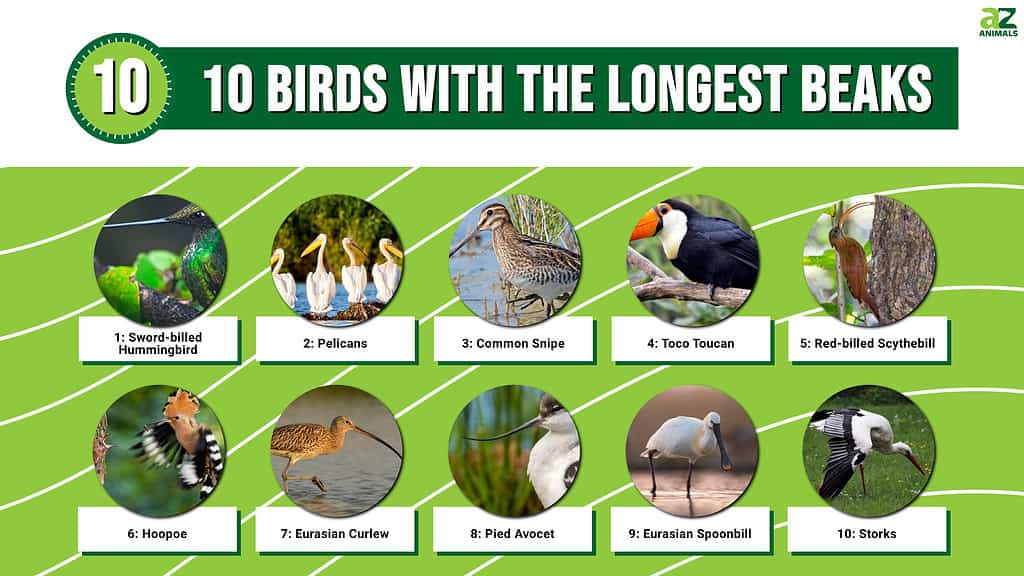
The size and shape of a bird’s beak usually give a person an idea of what it eats and how it catches what it eats. Birds such as cardinals have strong, conical bills that crack open nuts and seeds. Birds of prey have hooked bills to tear apart their food, and birds that have short, sharp bills are often insectivores.
On the other hand, birds with long, dagger-like bills use them for probing for and impaling their prey, whether it be fish, little reptiles, or amphibians.
Other birds that evolved to have long bills use them to get into flowers and find nectar. Perching birds with long bills might use them like extension poles to grab fruit or bugs. Here are ten birds, or types of birds with some of the world’s longest beaks.
#10: Storks

©iStock.com/Simon11uk
These birds evolved to wade in water and spear their prey, so they not only have some of the world’s longest beaks but long legs, too. Storks belong to the Ciconiidae family and are spread out among six genera and 19 species. Their bills are not only long but fairly robust as well as sensitive. This allows them to stick their beaks into murky water and find prey by touch.
Some storks include:
- Marabou stork: One of the ugliest creatures on earth, this bird with its bald, pink head, monstrous beak, and dangling gular sac was once hunted for its exceptionally soft down. It’s also the largest stork and can have a 12-foot wingspan and stand 5 feet tall. It lives in Africa.
- Wood stork: A few degrees less ugly than the marabou, this stork also has a bald head, though the skin is grayish brown. The baldness is not to make it easier to plunge the head into a carcass or trash pile like the marabou stork but to plunge the head into muddy water to find prey such as amphibians, insects, crustaceans, and fish. The wood stork is found in the southwestern United States and down into South America.
- White stork: The long bill of this much more attractive stork is red, but the rest of it is white with black wing feathers. Standing about 45 inches tall, the white stork wades in streams and marshes and eats amphibians and other small aquatic life. It’s found in Europe, Africa, and east to India and Pakistan.
#9: Eurasian Spoonbill
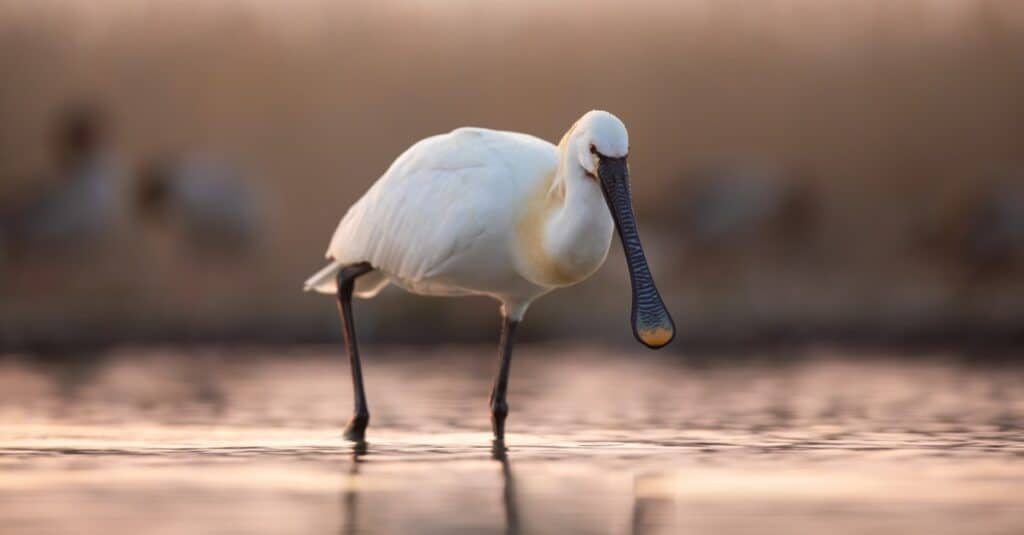
©iStock.com/JMrocek
This bird with its long bill and long legs look like a stork, but it’s not. Standing about 35 inches tall and found in northern Africa, southern Europe, and east into Asia, this bird gets its name because its bill is wide and flat at the end.
When it’s swept through waters of lagoons and marshes and kept slightly ajar, this long beak is the perfect trap for small aquatic life.
#8: Pied Avocet

©iStock.com/Ian Fox
The pied avocet is a much smaller wading bird than the stork and is found in Europe, Central Asia, and Russia. Its plumage is an attractive black and white, and its bill is not only long but thin and with an upward curve. Its other notable characteristics are its webbed feet, which are unusual for a member of the stilt family. It hunts in salt or brackish water and swishes its beak through the water to find prey. The avocet can also just swim out into the body of water, flip upside, and hunt the way ducks do.
Adults have white plumage except for a black cap and black patches on the wings and the back. They have long, upturned bills and long, bluish legs. These birds forage in shallow brackish water or on mud flats, often scything their bills from side to side in the water. They mainly eat crustaceans and insects.
#7: Eurasian Curlew
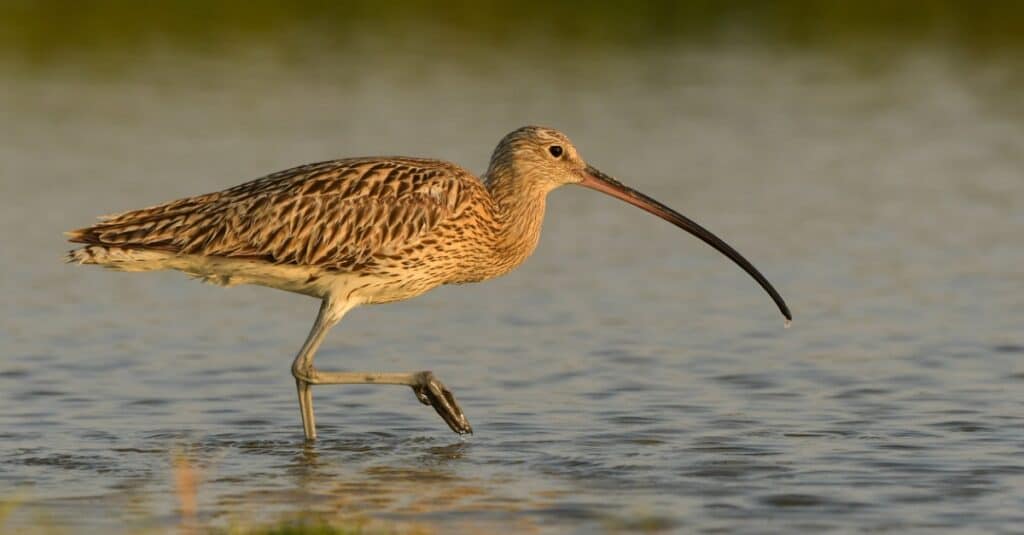
©iStock.com/SzymonBartosz
In contrast to the pied avocet, the long beak of the Eurasian curlew curves slightly downward. This bird with its somewhat drab plumage is found in the grasslands and peat bogs of Africa, Europe, Russia, and southern Asia. It makes up for its uninspiring looks by its beautiful song and its ritual combat over territory. During the winter, curlews fly to coastlines and estuaries and use their beaks to poke in the mud and sand for tiny crustaceans and worms. Unfortunately, the conservation status of the common curlew is near threatened.
#6: Hoopoe
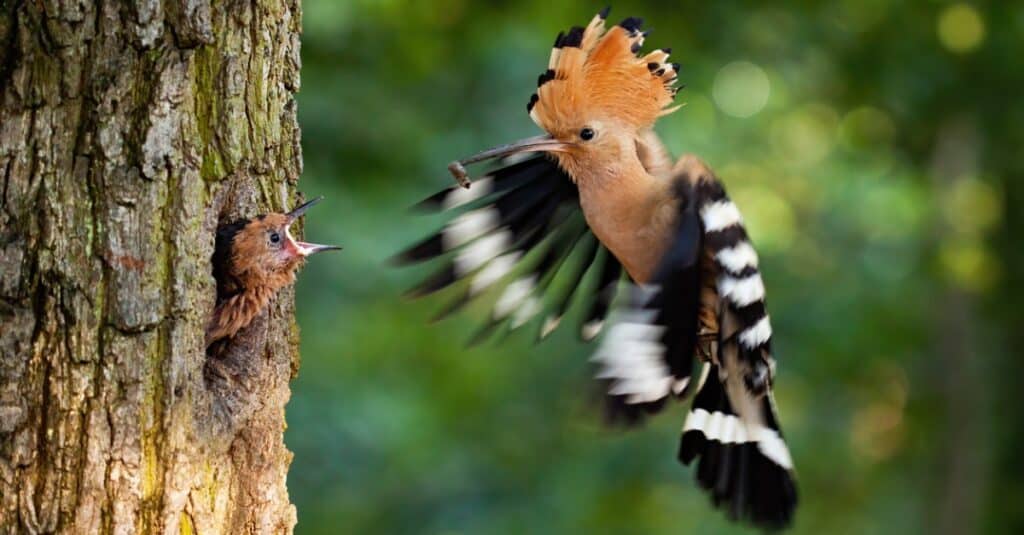
©iStock.com/JMrocek
This bird, native to Europe, Africa, and Asia is famous for both its spectacular crest and its long, very sharp, slender beak. Though it is rather earth-toned in cinnamon browns, dark browns, blacks, and creams, the colors arrange themselves in aesthetically pleasing patterns, including what can only be called zebra stripes. This is especially true when the bird flies and reveals the black and white bands of its wings and tail. As for that long bill, it is used to probe the ground for small lizards and insects.
#5: Red-billed Scythebill
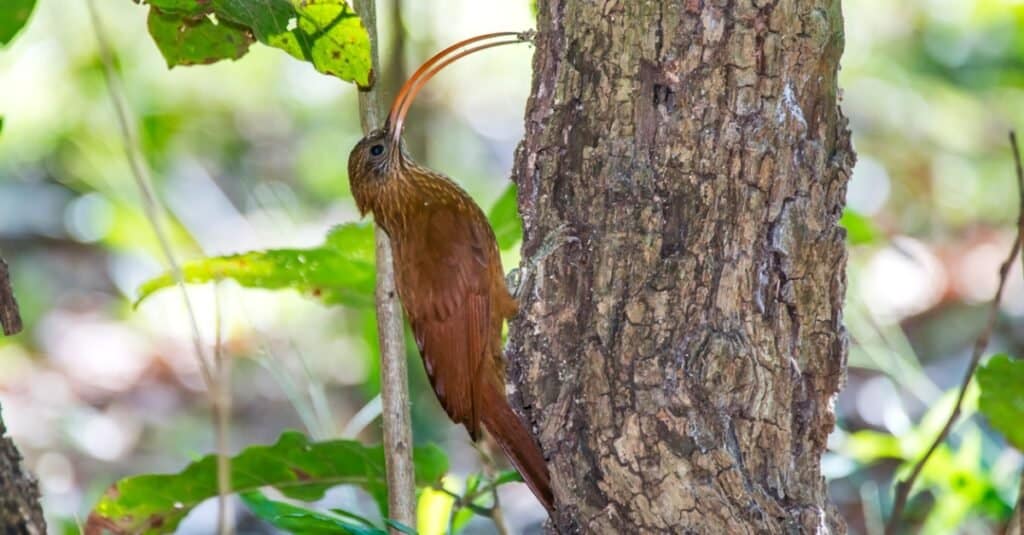
©Leonardo Mercon/Shutterstock.com
This bird with its otherwise ordinary rufous-brown feathers attracts attention because of its bill, which is, as its name says, long, red, and shaped like a scythe. The bird is a type of woodcreeper that’s found in the forests of South America and makes a living by crawling up tree trunks and using its beak to probe under the bark for insects and other small arthropods. The length and curvature of the beak allow for deep probing and a long reach.
#4: Toco Toucan
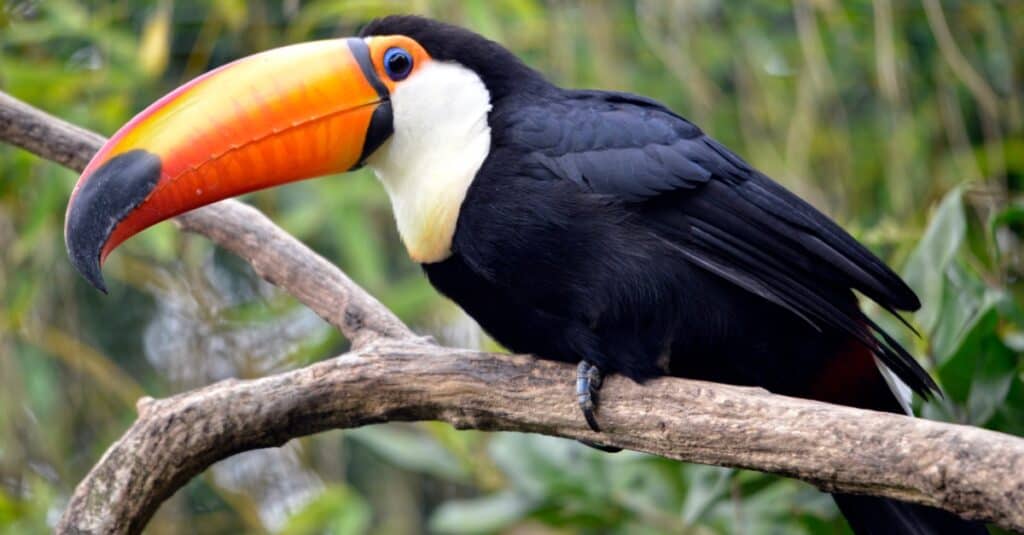
©iStock.com/Musat
The Toco toucan’s bill is not only exceptionally long, it is simply big. Sunset colored with a black tip, it is the body part that has made an otherwise merely interesting bird famous. This toucan’s beak looks much too heavy for it to carry around, but it is light, hollow, and serrated. It is the largest beak to body surface area of all the birds, even though the sword-billed hummingbird beak beats it when it comes to the length of the body. Biologists have wondered for centuries why the toucan has this bill. Some believe it’s to attract the opposite sex or intimidate rivals. It has been found that the bill does keep the bird cool and is always useful for nabbing fruit or prey that would be hard to reach.
#3: Common Snipe
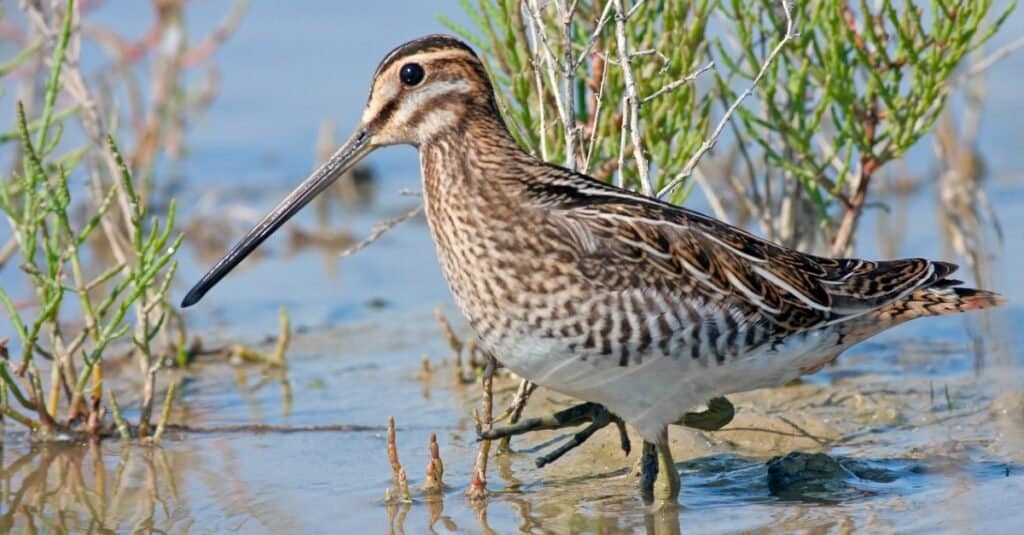
©iStock.com/VladimSu
This plump, smallish bird is also a wading bird and is found throughout Europe and Asia. It also winters in the warmer European countries and Africa. The snipe, with its brown and yellowish plumage and short tail, has the longest beak of any shorebird. Not only this, the bill’s tip is flexible and allows the snipe to probe into the mud for worms and other small animals. The bird also has the benefit of its eyes being near the top of its head, which allows it to search for trouble even as it feeds. The male is famous for doing a spectacular circling and diving courtship display.
#2: Pelicans

©iStock.com/CalinStan
Like storks, pelicans are water birds with long beaks, but their beaks come with an expandable pouch. This lets them scoop up fish and simply strain the unwanted water out of the pouch before they swallow the food. Pelicans are found in warmer areas around the world save the landlocked countries of South America. Types of pelicans include:
- Australian pelican: This bird is found in both Australia, New Guinea, and other areas in Oceania. It can be six feet in length and have an 8.5-foot wingspan. The bird has mostly white plumage with black on its primary wing feathers and a very long pink bill. Indeed, Australian pelicans have some of the longest beaks of any extant bird. The beak can be 18 inches long in a big male.
- Great white pelican: This big, white-feathered bird is found, patchily, from the Mediterranean to South Africa and Asia and breeds in Russia. During the breeding season, its feathers can take on a rosy hue. Its bill can be nearly 16 inches long. The great white pelican can form huge flocks and can be seen flying in breathtakingly precise formations.
- American white pelican: This large, fat bird can be close to six feet long, and much of that is taken up by its beak, which can be 15.2 inches long. Males are a bit bigger than females but other than that it’s difficult to tell them apart. It’s the only pelican to have a horn on its bill, but this horn only appears during the breeding season and is shed afterward. The American white pelican is found in Canada, parts of the United States, and down into Mexico and Central America.
#1: Sword-billed Hummingbird
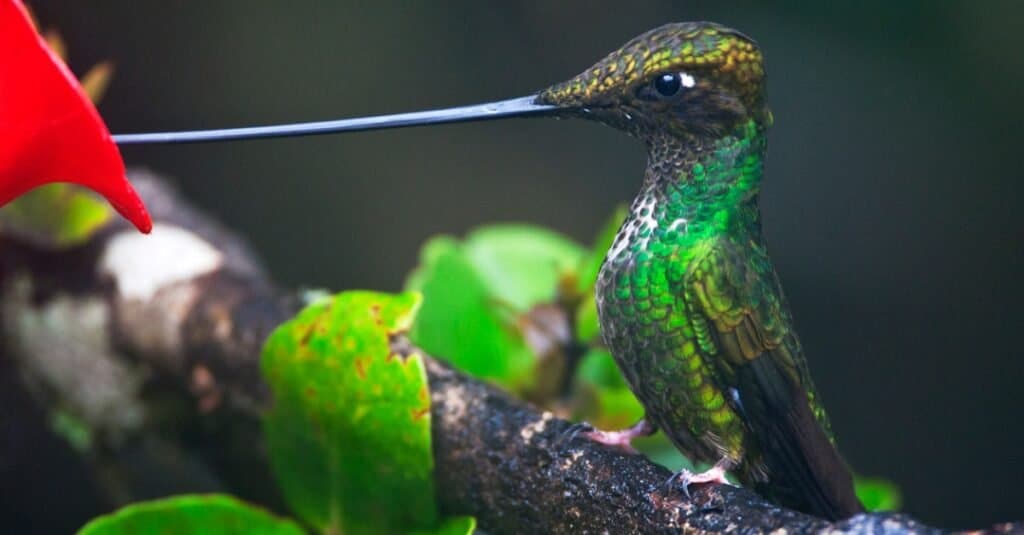
©iStock.com/AGAMI stock
The sword-billed hummingbird gets the number one spot because it is the only bird known whose beak is longer than its entire body. The bill developed, as in many other hummingbirds, to sip nectar from trumpet-shaped blossoms. It is so fantastically long that it is pretty much useless for anything else. While other birds can use their beaks to tidy themselves, this little bird of the Andes must use its feet. Interestingly, the beaks of the females are longer than those of the males.
Summary of birds with the Longest Beaks
Here is a list of the birds with the longest beaks:
| Rank | Bird |
|---|---|
| 1 | Sword-billed Hummingbird |
| 2 | Pelicans |
| 3 | Common snipe |
| 4 | Toco Toucan |
| 5 | Red-billed Scythebill |
| 6 | Hoopoe |
| 7 | Eurasian Curlew |
| 8 | Pied Avocet |
| 9 | Eurasian Spoonbill |
| 10 | Storks |
The photo featured at the top of this post is © feathercollector/Shutterstock.com
Thank you for reading! Have some feedback for us? Contact the AZ Animals editorial team.







